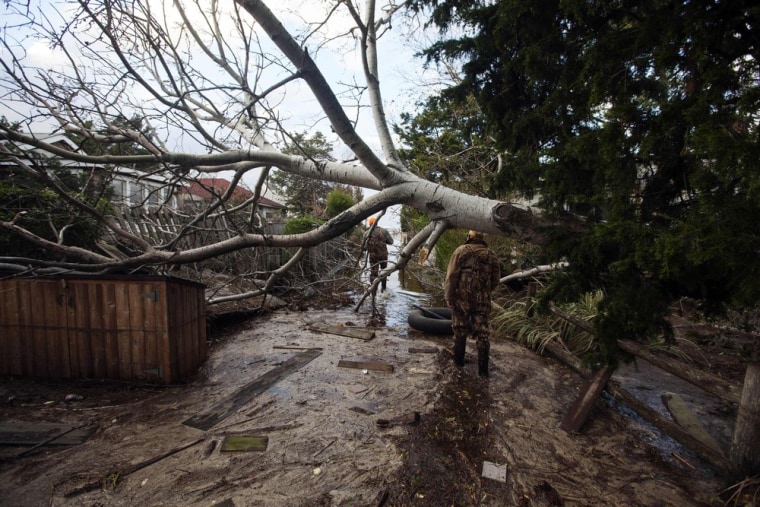
As insurance claims adjusters begin sifting through the wreckage of Superstorm Sandy, homeowners will learn in the next few weeks just how much of their loss is covered. Some of them many be in for some very bad news.
The insurance industry’s preliminary estimate pegs the total insured losses for the monster storm at between $5 billion and $15 billion. That figure covers only damage to residential structures and personal property covered by private insurances companies. Most flood damage is covered by the federally subsidized National Flood Insurance Program.
But many homeowners don't have flood insurance, either because of their location or because they don't have a mortgage. Also, a sort of Catch-22 clause in homeowner's private policies could provide some wriggle room for insurers, as it did after Hurricane Katrina in 2005.
Mortgage lenders typically require homeowners to carry flood insurance if they live in flood-prone areas. But Sandy’s record storm surge reached homes on higher ground that had not previously been considered high risk, according to Robert Hunter at the Consumer Federation of America.
“These surges went further than a lot of people expected,” he said. “So a lot of people don’t have flood insurance."
It will take weeks to determine just how many homeowners will have to pay for repairs out of pocket. But the statistics aren’t encouraging.
In New Jersey, where the monster storm made landfall, there are more than 2.2 million single-family homes in the state’s 20 coastal counties, according to Census data. Of those, only 231,000 – or about one in 10 – had a National Flood Insurance policy as of September 2011, according to FEMA data.
One big reason: While flood insurance typically is required by mortgage lenders, more than half a million homes in those counties don’t have a mortgage.
Homeowners who suffered damage in the storm also could get tripped up by a clause in their policies known as an “anti-concurrent causation” provision.
Basically, the clause means that if your house was damaged by two different causes, say wind and flood, but you can’t prove which one, the insurer doesn’t have to pay you anything.
“If you have wind coverage but no flood coverage, they may say you get zero,” said CFA's Hunter.
Insurers argue that the clause is needed to protect them from greater liability than the coverage they provided. If they had to pay to repair a house damaged by both flood and wind that was only covered for wind, they would effectively be on the hook for flood coverage.
The clause was invoked heavily following Hurricane Katrina, according to Sen. Roger Wicker, R-Miss.
“Following Hurricane Katrina, some in the insurance industry invoked the anti-concurrent causation provisions in their homeowner's policies to systematically deny coverage to consumers whose homes were destroyed by the storm,” he said last September at a hearing on reforming the National Flood Insurance Program.
Some homeowners were able to successfully challenge the Katrina claim denials in court. But in other cases, courts upheld the industry’s right to deny claims based on the policy clause.
Though some claims for shore-front houses will likely be subject to denial based on the anti-concurrent causation policy provisions, Sandy will likely produce many fewer such controversial claims, said Robert P. Hartwig, president of the Insurance Information Institute.
Because relatively few houses were completely swept away, it will be easier to establish whether damage was caused by wind or flood, he said.
“The evidence is all there (after Sandy),” he said. “You can look at home. If you can see the shingles are missing, clearly it’s wind. If there are fish in the basement, that’s clearly a storm surge.”
One thing homeowners covered by private insurance policies likely won't have the pay is the so-called “hurricane deductible.” Much like a deductible on a health care or auto policy, it exempts the insurer from paying an initial portion of any claim.
Hurricane deductibles range from anywhere between 2 to 5 percent of the covered amount, with higher deductibles written into policies covering property closest to the shoreline. For a house covered for $400,000 in damages, a 5 percent deductible would leave the homeowner on the hook for the first $20,000 in repairs.
Though the clause is common in private policies, insurers may have a tough time enforcing it on claims for Sandy-related damage. That’s because the storm was downgraded from a “hurricane” to a “post-tropical cyclone” just hours before making landfall.